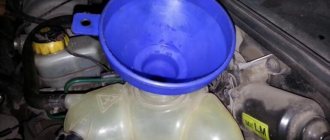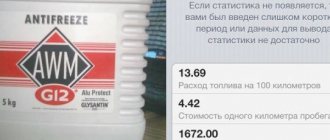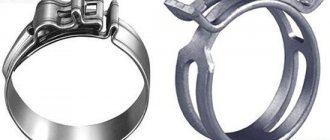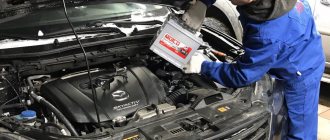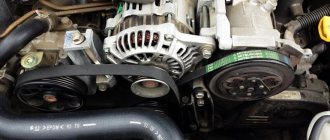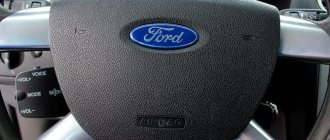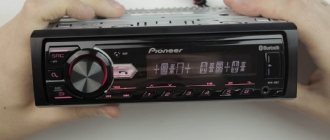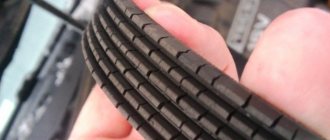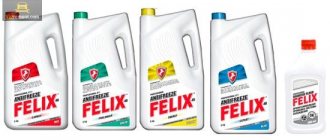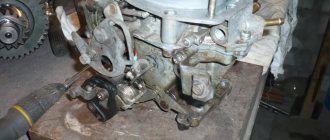03.12.2019
| (Votes: 3, Rating: 4.33) |
Issues discussed in the material:
- When is it time to add antifreeze?
- How to do it correctly
- How to properly add antifreeze to the cooling system
- What do Internet users think about it?
There is plenty of information available about car coolants. However, car enthusiasts have questions about how to add antifreeze, with what means and in what time frame. Let's clarify these points in our article.
How to properly add antifreeze to the cooling system
What is coolant needed for, inexperienced drivers may ask? Here's why: antifreeze is necessary to cool the engine, and in general the entire cooling system supplies and circulates coolant in the engine of the car.
In order for the cooling system of a car engine to work properly, every motorist must know how to properly and correctly add and refill antifreeze. This topic will be comprehensively covered in this article.
How does engine performance depend on antifreeze?
So, we know that without proper operation of the ODS, the engine can overheat, and in addition, if the cooling is poor, corrosion processes can occur. It is recommended to replace antifreeze or antifreeze every 40 thousand kilometers, but according to experts, such replacement must be done annually
High-quality antifreeze allows you to avoid corrosive processes, it is softer in structure and has many additives; its characteristics differ markedly from cheap liquids in a number of indicators.
There is a lot of information about antifreeze or antifreeze and how they work in the engine system too. However, not many people understand how to properly top up or fill them, but the condition of the engine and, in general, the entire operation of your car depends on this.
What you need to know when adding antifreeze
It is worth recalling this important rule: you cannot mix refrigerants with different characteristics. When mixing such a cocktail, as a rule, a precipitate forms, which will not evaporate in the air and will not disappear, but will systematically settle on the thin radiator tubes and other parts of the SOD and coke in the delicate parts and mechanisms of the system. That is why manufacturers recommend the use of those antifreezes that are suitable for your car, and those that are approved and initially fill the car’s cooling system.
Many car enthusiasts wonder whether it is possible to add water to antifreeze? The question is quite interesting, in small quantities and observing the correct proportions, this method is possible, but provided that it is distilled water and not tap water with various impurities in the form of chlorine, sodium, potassium and other chemical elements.
You should not focus on the color of the coolant, it will only confuse you completely. The color of antifreeze does not depend on its quality and composition. Sometimes liquids of the same shade can be completely different in chemical composition, and vice versa, multi-colored antifreezes will be compatible in structure, additives, and base. Therefore, when purchasing, you should pay attention not to the color of the coolant, but to its composition and main characteristics.
Why change the coolant?
Is it necessary to change the coolant at all? At first glance, the system is closed, no “nasty” from outside gets into it, antifreeze is cooked in its own boiler. What will happen to him?
However, it will be done. The main components of coolant are water and alcohol. But the main ones do not mean the most important ones. All the salt in antifreeze is contained in additives. They prevent corrosion processes, lubricate and protect. Their shelf life, alas, is not unlimited. As the additives degrade, antifreeze loses its beneficial properties. As a result, corrosion processes are inevitable, parts are destroyed, particles of metals and other materials settle, clogging the system components... And now the cooling does not cope with its tasks, which worsens the performance of the engine.
Important! It is better to change antifreeze without waiting for negative processes to occur. There are manufacturers' recommendations for this.
How to pour antifreeze into SOD
Modern cars require careful attention not only because they are quite expensive, but also because they are equipped with complex innovative mechanisms and systems. Today, antifreeze is mainly used to fill the engine, which is what we will take as an example when analyzing this issue.
Important! The main mistake that car enthusiasts make is pouring antifreeze into the radiator socket. Only those models that can be disassembled have a special hole.
But initially, a solid radiator system is not intended for pouring coolant into it. The liquid must be poured through an expanded tank, which allows it to be evenly distributed throughout all components of the cooling system.
When completely replacing the coolant with a new one, it is necessary to free all collapsible parts from the previous antifreeze by removing any remaining liquid from them, and its remains must drain through an additional plug located on the bottom of the radiator.
Of course, each hotel car has its own modification of the cooling system, so the owner should have an instruction manual to help. For example, English brands have non-standard drains and special holes for filling liquid. In general, the procedure for filling antifreeze is not complicated, and every car owner can carry it out independently.
Briefly about the main thing
The coolant for heating a private house allows you to efficiently and safely transfer thermal energy from the heating circuit of the boiler to the radiators, which in turn release heat to the surrounding space. The coolant must meet the following series of requirements:
- Complete heat transfer.
- Chemical inertness.
- Optimal operating temperature range.
- Absence of harmful components.
- Stability and constancy of operating parameters.
- Safety for people and the environment.
Water can be used as a coolant. It tolerates heat best, is free and accessible. However, it freezes already at zero degrees, causes corrosion and can form insoluble salts. Non-freezing liquids do not have such disadvantages.
Antifreezes are divided according to their chemical composition into ethylene glycol, propylene glycol, and glycerin. There are also special ones for electrode boilers and mineral ones. Antifreeze cannot be used as a cheap alternative. You can add antifreeze manually or with a pump. At the same time, monitoring performance characteristics and strict adherence to technology are extremely important.
Step-by-step instructions for replacing coolant
Buying antifreeze
First, you should purchase antifreeze that is suitable for all parameters. As a hint, you can use the car's operating instructions, which must contain the appropriate recommendations.
Starting the car
Next, we start the car’s engine and let it run for about 10 minutes, then turn on the heater to maximum and then turn off the engine.
Draining old antifreeze
The next step is to drain the old antifreeze from all parts of the cooling system. An important point here is the correct positioning of the car - the front should be slightly lower than the rear. This will allow the liquid to actively drain from all parts.
Next, take a look at the expansion tank plug to remove excess pressure. The coolant cools down quite quickly, so there is no risk of getting burned, but you should be careful when opening the plug. Then an outlet opens for drainage in the radiator, of course, into specially placed containers for it, which must subsequently be disposed of.
Flushing the system
After completely getting rid of the old coolant, the system is completely flushed. Such an event is carried out in the event that you switch to using new brands of antifreeze or when the cooling system requires urgent maintenance, as it has not been carried out for a long time. Using distilled water, corrosive deposits are washed off and traces of scale are removed.
Particularly difficult contaminants are removed using special washing. Water allows you to get rid of dirt on the system components in 10 minutes of washing; if this is not enough, you can repeat the procedure several times. At the same time, parts are checked for wear. If they require replacement, this is the best time to check the gaskets, pipes, and fittings.
Filling with new antifreeze
After the final cleaning of all parts of the system, new working fluid is poured into the radiator neck or expansion tank. This requires attention, especially for those motorists who perform such an action for the first time: it is important not to confuse the holes and not to pour antifreeze into the washer reservoir instead of the expansion tank; they are located nearby and similar in appearance. There is no need to rush, but there is also no need to stop, since if air gets into the system, the engine will need to be pumped for a long time.
How to add antifreeze yourself
It is necessary to add coolant to the car engine only through the corresponding hole located on the expansion tank. What exactly needs to be done:
Remove the lid and check for the presence of liquid. If the level is at a minimum, this is a reason to be wary. At the maximum level, there is also a fear of system failure. The best option is the “golden mean”.
Typically, adding antifreeze occurs more often in winter, since the liquid is lost when the engine cools and warms up during machine downtime and idling. Do not be upset that antifreeze decreases - this is a normal process in winter. But if the liquid decreases too quickly, then you should think about checking the system or replacing the refrigerant with a more stable one. It is necessary to choose an antifreeze with a different formula that can withstand freezing and expansion.
How to change coolant
Important! Before you begin the replacement process on the VAZ 2109, you must disconnect the “-” terminal from the battery
Replacement should only be carried out when the engine is cool.
You can change the coolant only when the engine has completely cooled down!
Draining process
- To drain the cooler, place your car on a horizontal platform. If there are no such conditions, then try to make the front of the car slightly higher.
- Move the heater control lever all the way to the right.
Heater lever position - Remove the ignition module with bracket.
- Unscrew and remove the reservoir cap.
Unscrew the lid of the antifreeze tank - Place a container under the drain plug, the volume of which should be approximately 10 liters to drain the old cooler.
- In order to drain the old cooler, unscrew the plug located on the engine cylinder block.
Unscrew the plug on the cylinder block - Drain the old coolant completely.
- Wipe the engine if liquid gets on it.
- Unscrew the drain plug located on the radiator and drain all waste fluid from it into a previously prepared container.
Radiator drain plug
Filling process
- We tighten the drain plug located on the radiator and the plug on the cylinder block.
- Loosen the clamp holding the coolant drain hose and disconnect it from the throttle fitting.
- The hose must be held by hand.
- We pour new coolant into the tank and wait until it appears in the hose. Fill approximately 4-5 liters.
- Reinstall the hose onto the fitting.
- Install the clamp and tighten it.
- We pour coolant into the expansion tank until its level rises to about 0, a total of 7-8 liters should be required.
- Screw the tank cap tightly until it stops.
- We put the ignition module in its place.
- We start the car and warm up the engine to operating temperature.
- We turn off the car and check the antifreeze level.
- If necessary, top up. The level should be around about.
Which antifreeze to choose
Antifreeze is used in the cooling system of vehicles. It contains: ethylene glycol, additives, water and dye. Thanks to this composition, the liquid does not freeze at low temperatures. Coolant is usually changed after repairs or when seasonal temperatures change.
Before use, you need to understand the types and classification.
- G11. This fluid can be replaced every 2 years.
- G12. The liquid is most often red, sometimes purple or pink. Changed every five years.
- G12 plus. This antifreeze lasts for more than five years.
- Antifreeze. Created for use in VAZ cars.
The composition of antifreeze has never changed. Only the ratio of elements can be different. Some fluids can withstand temperatures down to -36°C, and even at such a low temperature, antifreeze does not freeze, but becomes viscous.
There are two types of refrigerant according to their water content - antifreeze and antifreeze concentrate. The first one can be poured into the system without adding water. Its freezing point is approximately -40°C. Antifreeze concentrate is designed for lower temperatures and is diluted with clean water when pouring.
Mixtures with ethylene glycol have some peculiarities. This mixture is very toxic, so safety precautions must be taken when using it. However, there is another option - a liquid with propylene glycol. The marking of antifreeze based on this compound is designated as G13 or OAT.
Features also lie in the additives they contain. Ethylene glycol antifreeze contains phosphates, silicates and nitrites. These connections are necessary to protect the metals they come into contact with. Other surfaces, such as rubber and plastic, are, on the contrary, damaged.
Hybrid antifreezes of the G11 group contain a small amount of phosphates, this prevents the formation of scale and sediment in the cooling system. At the same time, the group is distinguished by a large amount of nitrites, which form toxic compounds. The service life is short, approximately 3 years.
The new generation antifreeze of the G12 group does not contain silicates. To prevent scale formation and corrosion, the composition includes carboxylates and inhibitors. They lead to the formation of a film on the surface of the cooling system, which extends the life of the additives. This group of antifreeze can be used for up to five years. This coolant is not compatible with brass radiators.
Class G12 plus can be mixed with other antifreezes. This group of coolant does not contain phosphates, nitrites or silicates. The liquid first appeared in the 90s and was made on the basis of carboxylic acids. There are no harmful additives in the composition, so the shelf life can be 5 years. However, they should not be mixed with coolant containing ethylene glycol.
For those who are not familiar with the classes of coolants, manufacturers have come up with color codes.
- Refrigerant of blue, blue or green color belongs to class G11, service life is 2-3 years.
- Antifreeze of orange, pink or bright red color belongs to the class G12, G12+, G12++. Works properly for 5-8 years.
- The purple or yellow liquid is also intended for long-term use and belongs to group G13.
However, recently, manufacturers have been producing antifreeze without paying attention to the light, thereby confusing users. Therefore, it is best to navigate by coolant classes. You can determine which antifreeze is needed by following the instructions for the car. Manufacturers know well what metal the power unit consists of. If it is necessary to add antifreeze, use the one that was previously poured into the cooling system.
Recommendations from manufacturers
Manufacturers always indicate the recommended period for using the liquid on the label. At the end of the specified period, it should be changed, since its unique properties are lost.
How often should you change the antifreeze in your car? Replacement intervals depend on the manufacturing technology of the product and its standard. Automotive industry giant Volkswagen proposed its own classification, which was picked up and actively used by other companies:
G11 (green) - traditional solutions that consist of inorganic silicate compounds and other synthetic elements. The advantage of this class of products is the formation of a special protective layer on engine parts, which prevents the development of corrosion. When using a technical solution longer than the prescribed period, the protective layer precipitates, the level of protection deteriorates, and flakes clog system components. The update interval recommended by the manufacturer is 24 months. Antifreeze has similar qualities, so the recommended period of use is also 2 years.
G12 (red/orange) - standard designating coolants for the manufacture of which organic acids were used. It differs from the traditional type in its heat transfer properties and targeted effect on the source of corrosion, preventing its spread. After the expiration of the permissible service life, the substance loses its properties too quickly, so they must be drained every 5 years.
G13 (yellow) – new generation of (lobrid) coolants. The main element of this class of solution is propylene glycol - an environmentally friendly and reliable component. According to the principle of operation, antifreezes of this class are similar to the G12 standard. Replacements in a car are carried out every 5-10 years, but some popular companies claim that their product does not lose its properties throughout the entire life of the cooling system.
How to add antifreeze
When pouring antifreeze, you must remember that mixing different coolants is unacceptable. This will lead to sedimentation, coking of the radiator tubes and damage to other parts of the mechanism. Topping up is carried out only through the opening of the expansion tank.
Most often, the procedure is carried out in winter. This is due to the use of a large amount of liquid when cooling and heating the car. If the number of such top-ups becomes too large, it is necessary to change the antifreeze to another one that is more resistant to temperature changes.
Where to replace
It is recommended to carry out work related to the maintenance of the vehicle cooling system in specialized car services. In the absence of the necessary experience and knowledge, a number of serious mistakes can be made in the process of replacing the coolant. This can lead to various consequences. Firstly, incomplete draining of the old composition risks the fact that fresh antifreeze will mix with the remnants of the used coolant and quickly lose its performance properties. Secondly, the used liquid must be properly disposed of. All the necessary conditions for this are available only in specialized services. Used antifreeze should not be bottled and thrown into regular trash cans, as this causes great damage to the environment.
Basic rules for adding antifreeze
Let us remind you that mixing different refrigerants is unacceptable in most cases, since at the output the mixed cocktail may precipitate, which will not disappear on its own, but will begin to systematically coke the thin radiator tubes and other delicate parts of the cooling system. Therefore, it is worth filling only with fluids indicated for use, which have received the approval of the car manufacturer, and only adding the same component that fills the already existing SOD with its base.
The question of how antifreeze or antifreeze behaves when added to ordinary water can be left open. Concentrates of these substances give excellent performance with water in certain acceptable proportions, again if distilled water is poured in, and not a composition of chlorine, sodium, magnesium and potassium, which often comes out of the tap.
Again, we remind you that the color of the coolant does not affect its composition in any way - green, blue, and red liquids can be compatible with each other, while liquids of the same color, for example, yellow, can have completely different structures, additives and bases.
Recommendations for using coolant on used cars
Engines on used cars in most cases are not in perfect technical condition. Often, the expiration date of consumables on such machines differs significantly from the recommendations for new vehicles.
How often should antifreeze be changed in a high mileage car? It is impossible to name the exact time period for using coolant. It is necessary to independently monitor the condition of the antifreeze using one of the methods suggested above. Antifreeze should be changed immediately if it has been diluted with water or a substance from another manufacturer.
How to add antifreeze to the cooling system?
Modern cars mainly use antifreeze; using its example, we will tell you how to properly fill and top up this substance for normal operation of the cooling system.
The most common mistake is pouring liquid into the radiator socket. Indeed, this unit has a filling hole, but only in those models that are subject to disassembly.
A tightly welded radiator system does not involve pouring and topping up directly; antifreeze enters it through the expansion tank, into which the coolant is mainly poured, then flowing evenly to all components of the cooling system.
By the way, when the coolant changes completely, the main reason for which is a simple change of brand or replacement of the old one with a new one, then collapsible radiator models are drained separately, with their own lower hole, and the rest of the liquid drains through an additional plug, which is sometimes covered with a protection on the bottom.
In this matter, the instructions are always helpful, since different car models may have their own modifications of the cooling system and non-standard drain and fill holes, especially for English-made cars. Otherwise, the procedure for filling antifreeze and other coolants can be divided into several simple steps. There is nothing complicated about this, so changing the refrigerant can be done independently.
How often should I change
In this regard, the question arises, how often to change the coolant? It depends on the type of antifreeze, more on that below. In the meantime, let's consider situations when you need to change antifreeze urgently, without waiting for time to expire:
- significant clouding of the refrigerant, change in its color;
- the appearance of sediment, flakes, mechanical particles in the coolant;
- increased foaming;
- thickening - antifreeze becomes like jelly;
- significant reduction in fluid volumes;
- adding antifreeze of a different standard.
The last point is worth mentioning separately. Mixing incompatible classes of coolant - for example, silicate with carboxylate, can kill all the beneficial properties of these products. Often flakes and sediment form in this mixture, and it can also become very thick. Therefore, only coolants of the same class can be mixed and added.
It is also worth saying that in older cars with high mileage, antifreeze requires more frequent replacement than in new ones. This is due to the fact that corrosion spots inevitably form in the engine over time. Antifreeze tries to neutralize them, absorbing rust particles and losing their beneficial properties. In this case, the need for replacement will be indicated by a rusty tint of the liquid.
Recommendations from antifreeze manufacturers
Antifreeze manufacturers always indicate on the product packaging the recommended replacement period. Usually, after this period, the first warning signs appear, signaling a deterioration in quality.
These intervals depend on the production technology and the liquid standard (if you use the classification of antifreeze from the Volkswagen concern, borrowed by many manufacturers):
- G11. This standard includes traditional antifreezes. They use inorganic additives - silicates and other substances. Their peculiarity is that they form a physically tangible layer on the inner surface of parts, which prevents the formation of pockets of corrosion. If you do not change such antifreeze on time, this layer begins to precipitate, the protection deteriorates, and the fallen particles clog the system components. This happens faster than with other antifreezes. The recommended replacement interval is 2 years. TOSOL also has similar properties, so its replacement period will be similar.
- G12. This standard is used to designate coolants produced using organic (carboxylic) acid technology. The resulting liquid has excellent heat transfer properties and does not create any layer, like traditional ones. Its corrosion inhibitors act in a targeted manner. They are directed to where pockets of corrosion occur and prevent their further spread. However, over time, carbon fibers lose their grip, corrosion spreads, and the properties of antifreeze deteriorate. It is recommended to change them every 5 years. The same applies to improved carboxylate antifreezes - G12++ and hybrid - G12+.
- G13. This is the newest generation of coolants called lobrid. The main difference is that it is based on propylene glycol (the rest use ethylene glycol), a more environmentally friendly and more reliable base. Otherwise, they are similar to carboxylate ones. Such fluids have the longest service life - from 5 to 10 years, and some manufacturers recommend not changing the coolant at all throughout the entire service life of the cooling system.
Step-by-step instructions for replacing antifreeze
1. Buy the necessary high-quality antifreeze (for characteristics and indications, see the instructions for using the car, checking the manufacturer’s label).
2. Start the car and let it run without load for 10 minutes, then turn or set the interior heater to the maximum maximum position, in other words, turn on the heater to its fullest. After this, turn off the engine.
3. Drain old antifreeze from the entire cooling system.
To do this, it is better to position the car so that its front part is lower than the rear part, then the coolant will drain more actively from all the nooks and crannies. Then you need to turn the expansion tank plug so that excess pressure finds a way out (in some models you need to turn the plug on the radiator, and sometimes you need to turn two plugs at once). After the liquid in the system is not pumped, it will quickly cool down and will not allow you to get burned. As soon as the plug can be touched with an unprotected hand, it should be opened completely. Then also open the drain outlet at the bottom of the radiator, first replacing unnecessary containers in which the used antifreeze can later be disposed of.
4. Flushing the system.
After that. Once all the coolant has been completely drained, it is necessary to flush the cooling system.
This is done only when switching to new brands of antifreeze or in the case when the system has not undergone preventive maintenance for a long time. Distilled water perfectly washes away corrosive deposits and removes scale. If dirt has accumulated, then you should use special flushes for the cooling system, which will help remove the dirt.
If you decide to use ordinary water, then this procedure will have to be repeated two or three times. Namely...fill in the flush, close the taps, and perform this operation only on a cold engine. Then close all the plugs and run a flush for 10 - 15 minutes (or as indicated in the instructions) to clean the system. Then perform the first two steps in the same order as when draining the used antifreeze. If you want to save money, then the first flushing of a very dirty cooling system can be carried out under the pressure of ordinary water, and only then use special means or distilled water. On average, three washing lines are enough for the SOD to become like new. Yes, one more moment. It is at this time that you should check all gaskets, fittings and pipes for wear and replace them if necessary.
5. Fill with antifreeze. After cleaning the system, fresh working antifreeze, which was purchased earlier, is poured in.
How to add antifreeze correctly?
Any addition of antifreeze and other refrigerants to the cooling system occurs only through the opening of the expansion tank.
To do this, you need to remove the cap and check for the presence of liquid. The minimum level should be alarming, and the maximum over the course of a month is beyond the norm, so it is better that there is a golden mean.
As mentioned above, you can only add antifreeze with the same composition, regardless of color, but it is better to use the same manufacturer, since there are differences in additives even for completely identical coolants, depending on the batch.
Topping up is carried out most often in the winter season. This is associated with the loss of fluid during cooling and heating (idling car, starting at idle). Such additions are normal and should not be alarmed. If antifreeze consumption becomes high, and a system check shows no malfunctions, then you should consider changing the refrigerant with a more resistant formula to freezing and expansion.
When to top up
The need to add coolant may arise for several reasons:
- A noticeable decrease in the level of antifreeze in the system. This is easy to notice if you pay attention to the marks on the expansion tank. The contents must not be below the minimum level, otherwise antifreeze must be added. If, after adding, its level quickly drops again, then there is a leak in the cooling system that needs to be repaired urgently.
- End of service life. There are several types of antifreeze: G11, G12 and G12+, G13. They differ from each other in the presence of various additives, which determines the service life of each type: from 2-3 years for G11 and 5 years for G12 and G13. But if problems with cooling arise during its service life, then it must be replaced ahead of schedule.
- The safety release valve on the expansion tank began to operate regularly. This indicates that the amount of coolant is insufficient.
What considerations are important to follow when creating mixtures?
- Without much concern for the operation of the engine in your car, you can mix various antifreezes with each other, including expensive versions 12 and 13, if they have a common base and main operating components that meet established quality standards. It is also important to take into account the difference between manufacturers, especially the fact that you should not mix even one type of antifreeze from different manufacturers.
- Various types of engine cooling mixtures (with artificial and natural additives) can be mixed with each other if the manufacturer indicates this.
- Keep in mind that poor compatibility of engine cooling mixtures means an increased chance of a reaction between internal additives and components in the antifreeze itself. This can have a very bad effect on the performance of the vehicle.
What needs to be added
You can only top up the type that was previously filled into the engine cooling system. In addition, the vehicle manufacturer's recommendations regarding the permitted type of fluid should be followed.
You can only mix products of the same type (class), which use the same additives. The type is determined by the corresponding markings on the packaging (G11, G12 and G12+, G13), and the color of the liquid does not play any role. The exception is the G12+ type, it can be mixed with G11 and G12.
When purchasing a liquid, you still need to pay attention to its concentration. Ready-to-use formulations and concentrates are available for sale. Before adding to the cooling system, the latter must be diluted in accordance with the manufacturer's instructions.
What you need to know to avoid mistakes
Correctly mix liquids of the same class. The exception is adding G12+ antifreeze, which can be added to G11 and G12. If you do not adhere to this rule, an insoluble sediment may form, which will gradually clog the pipes and cause premature engine wear.
It is strictly forbidden to pour antifreeze into antifreeze, because they differ greatly in chemical composition.
The coolant is produced both in the form of a mixture, which can be poured immediately, without preliminary preparation, and in the form of a concentrate.
It is forbidden to take concentrated products for refilling, even if the classes of antifreeze are the same: first, the concentrate is diluted according to the instructions. Proportions are often determined by the planned operating temperature conditions.
When can you add water?
If the contents of the expansion tank are below the minimum permissible level and it is not possible to add the required type of coolant to the system, then in this case it is possible to use water for topping up. But in this case the water must be distilled. Untreated water can clog the cooling system and react with various chemical additives in antifreeze.
After using water, it is necessary to completely replace all liquid in the heating system with that recommended by the manufacturer.
It is worth noting that water can only be added in small quantities (100-200 ml). This is the volume of water that will not be able to increase the freezing point of the coolant.
It is not recommended to add water in large quantities during the cold season; it can freeze and rupture the pipes of the cooling system.
Is it possible to dilute antifreeze with water?
What to put into the cooling system of a diesel engine
Car enthusiasts are often faced with a situation where they need to add antifreeze to the cooling system, but they don’t have the necessary liquid on hand, and the nearest store is not close. The first thought that comes to mind is to add regular water. But before you do this, you need to know whether it is suitable for these purposes.
When and why to dilute
Since antifreeze contains a significant portion of water, nothing bad will happen when it is added. In this case, the concentration of antifreeze will simply decrease and the more water you add, the worse its properties will be. However, there are situations when it is recommended to dilute the coolant. This has to be done, as a rule, if the antifreeze has been subjected to boiling, during which part of the water has evaporated and the liquid in the cooling system has become more concentrated.
Mixing in summer and winter
Basically, water has to be added to antifreeze in the summer, since the liquid evaporates more actively. Add water in accordance with the following recommendations:
- if initially the engine cooling system was filled with a concentrate that had not previously been diluted, and about 100–250 ml of antifreeze was used, then you can safely add distilled water to it;
- If there is significant evaporation of antifreeze, it is better to bring the level to normal using the original composition. If the brand of liquid filled is unknown, then distillate should be used for dilution, and the antifreeze should be replaced in the fall.
If the antifreeze has evaporated in large quantities, then it is better to bring it up to normal with the original composition
In winter, adding water in any quantity is prohibited. Otherwise, there is a high probability of problems with the cooling system or engine as a result of freezing, which will lead to expensive repairs.
What kind of water is suitable
The ideal option for diluting antifreeze is distillate. It does not contain calcium and magnesium. It is not worth using ordinary water for the purposes under consideration, since it negatively affects the components of the cooling system. If you use such water to dilute antifreeze, it may precipitate. Tap water can be filled only if the hardness level is low - no more than 5 mEq/l. If it is not possible to determine the hardness, then water and antifreeze should be mixed in small quantities and if there is no sediment, it can be added to the system.
It is best to use distilled water to add to antifreeze.
Manufacturer's recommendations
If you follow the recommendations of antifreeze manufacturers, they prohibit adding water to the product in question. This is explained by the fact that antifreeze initially contains various additives that extend the life of the cooling system, lubricating the necessary components and providing better engine cooling. Water will only worsen these indicators. While domestic cars used to use water without any concerns, the cooling system of modern cars is made of aluminum alloys, which are susceptible to corrosion from water with a high hardness index. As a result, the radiator becomes clogged over time, which will lead to constant overheating of the engine.
Precautionary measures
Every motorist can add coolant to the system, but even in such a simple procedure it is necessary to adhere to a number of rules:
- You cannot unscrew the expansion tank cap “hot”; you must wait until the engine cools down, otherwise hot liquid under pressure may splash out of the container and cause a serious burn.
- Antifreeze is added to the system only when the engine is cold; hot and cold components must not be mixed.
- When adding water, only distilled water should be used in small quantities and only in emergency cases.
- If water has been added to the antifreeze, it must be completely replaced as soon as possible.
- Do not add more coolant than normal, because when it heats up, the pressure will splash it into the engine compartment.
- To avoid the formation of an air lock in the system, the car must be placed on a slope, so the expansion tank will be higher than the rest of the system elements. In this case, the liquid should be added in a small stream so that air has time to escape through the opening of the tank.
An insufficient level of antifreeze in the cooling system leads to overheating of the engine, which can cause many problems with the car. Therefore, it is necessary to regularly check the coolant level and add it to the system in a timely manner, taking into account the precautions described above.
What can be added and in what quantity?
Where does antifreeze go: causes and methods for solving leaks
There are several types of antifreeze. You cannot mix them with each other, but you must add them strictly according to the marks. There is an opinion among car enthusiasts that some types of coolers are compatible with each other in terms of their chemical composition, but it’s still not worth taking risks and mixing them. To avoid unpleasant situations and machine breakdowns, use one type of fluid and buy it from trusted manufacturers.
When adding any water (regular or distilled), antifreeze may freeze in winter. If there is no fresh portion of antifreeze, add water only in the warm season. Never dilute the coolant with other chemicals. As a last resort, use plain water, but do not overuse it.
The lack of antifreeze in the tank can take the driver by surprise before the winter cold. To prevent this from happening, before the winter season, completely change the cooler and fill in a new one.
You need to spend time monitoring the condition of the coolant, otherwise it can be fraught with bad consequences for the car. If you check the antifreeze level in a timely manner, the engine will work properly, and the car will serve you for many years.
To maintain the temperature of a running engine, the driver needs to know how to add and pour antifreeze into the engine cooling system (ECS) correctly.
The SOD is designed to store coolant (coolant) and pump it through the engine cooling jacket, a large radiator and its smaller counterpart, which is used to heat the interior. If the level of antifreeze or antifreeze is insufficient, the power unit will overheat, and air pockets will form in the ODS.
Depending on the characteristics of the fluid, it may be used for the time specified by the manufacturer and then must be replaced. Topping up should be done as needed, regularly monitoring the fluid level in the system.
The presence of certain additives in the coolant, which is often indicated by the color of the composition, prevents the development of corrosion processes and the formation of scale.
It is important to remember that adding antifreeze to antifreeze and vice versa is prohibited, as this will lead to undesirable chemical reactions, the appearance of sediment and deterioration of the fluid’s characteristics
When purchasing antifreeze, you need to keep in mind that some manufacturers tint their product for marketing purposes.
